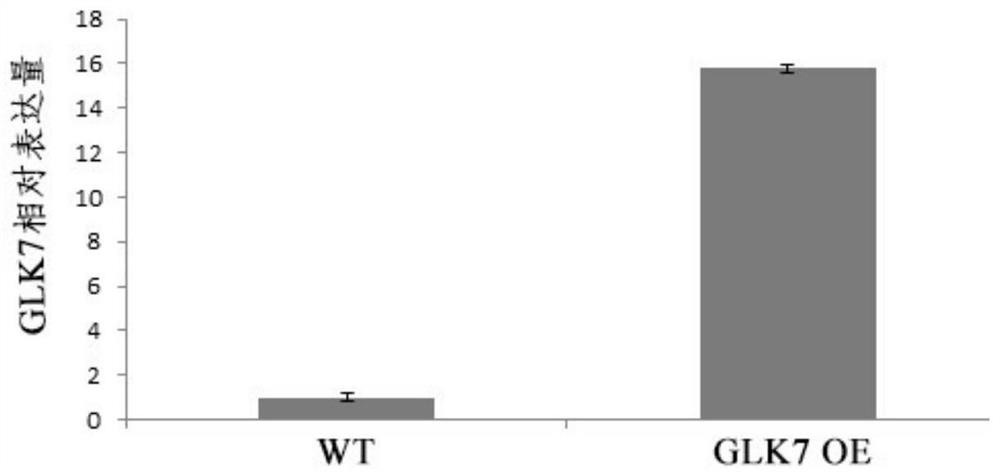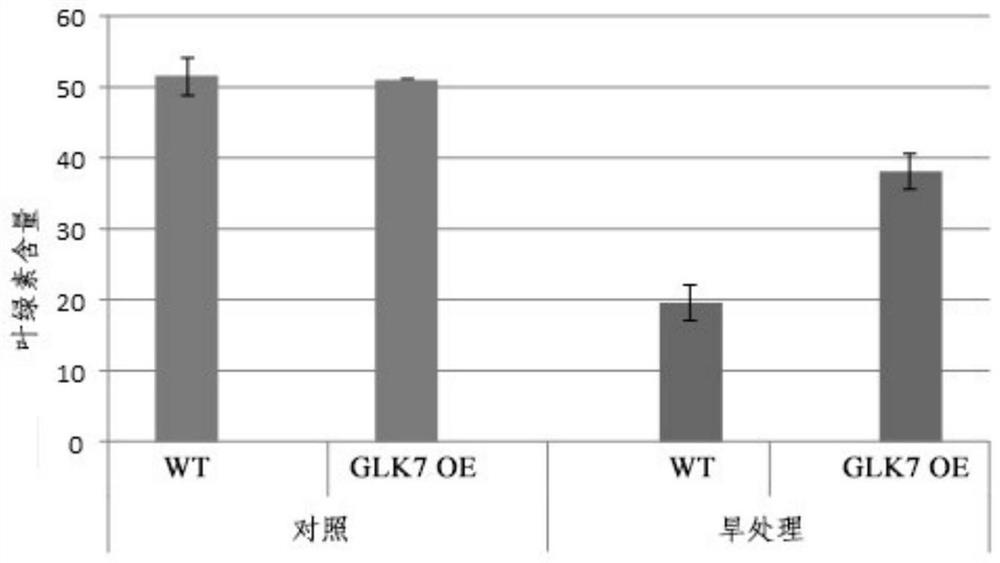Application of glk7 protein and its coding gene in plant drought resistance
A technology that encodes genes and proteins, applied in the field of plant genetic engineering, to achieve good growth conditions, improve plant drought resistance, and shorten the cycle
- Summary
- Abstract
- Description
- Claims
- Application Information
AI Technical Summary
Problems solved by technology
Method used
Image
Examples
Embodiment 1
[0039] Embodiment 1, the construction and detection of GLK7 gene overexpression vector
[0040] In order to study the molecular mechanism of GLK7 family proteins in plant drought resistance, total RNA was extracted from B73 maize (Zea mays L.), and cDNA was obtained by reverse transcription. The GLK7 gene (nucleoside The acid sequence is shown in SEQ ID NO.1, the amino acid sequence is shown in SEQ ID NO.2), and the primer has a restriction site, which is connected to the overexpression vector after digestion.
[0041] Carrier construction method:
[0042] (1) The total RNA of B73 corn was extracted with the RNA extraction kit of Magen Company, and the specific steps were referred to the instructions of the kit.
[0043] (2) Use the reverse transcription kit from Thermo Company to reverse transcribe the RNA into cDNA, and refer to the kit instructions for specific steps.
[0044] (3) Use cDNA as a template and F and R as primers to amplify the cDNA of GLK7 gene, run electropho...
Embodiment 2
[0052] Embodiment 2, construction and detection of GLK7 gene overexpression plant
[0053] The pBCXUN-GLK7 overexpression plasmid constructed in Example 1 was transformed into competent Agrobacterium strain EHA105 by heat shock method, and positive clones were identified by colony PCR. Inoculate a single colony of Agrobacterium correctly identified in 2-3 mL of liquid medium containing 100 μg / mL kanamycin and 50 μg / mL rifampicin, culture with shaking at 28 °C overnight, and transfer a large amount of liquid containing antibiotics the next day Shake culture in the medium, collect the cells after several transfers, and resuspend to OD 600 Between 0.8-1.0. The obtained recombinant Agrobacterium suspension was used to infect the young B73 maize embryos picked out under aseptic conditions, and the callus was induced to form seedlings. The transgenic plants were self-propagated to obtain the T3 generation for subsequent experiments. The RNA of the wild type and different transgen...
Embodiment 3
[0054] Example 3, phenotype detection of GLK7 gene overexpression maize drought treatment
[0055] Add 140g of soil to each small pot, add water to the tray, put 4 seeds in each small pot, cover with 50ml of soil, pour out the remaining water in the tray after absorbing the water, and put a seedling with uneven growth after emergence Remove it, add 1L of water in the tray, drain the water after it is full, start the drought treatment, and continue to observe the growth of the wild-type and transgenic plants after the drought treatment. Wild-type and transgenic plants were duplicated in 2 pots each. figure 2 It showed that the growth condition of the transgenic plants overexpressing GLK7 was better than that of the wild type, and the leaf wilting degree was lower than that of the wild type, which indicated that the transgenic plants were more drought-resistant than the wild type.
PUM
 Login to View More
Login to View More Abstract
Description
Claims
Application Information
 Login to View More
Login to View More - R&D
- Intellectual Property
- Life Sciences
- Materials
- Tech Scout
- Unparalleled Data Quality
- Higher Quality Content
- 60% Fewer Hallucinations
Browse by: Latest US Patents, China's latest patents, Technical Efficacy Thesaurus, Application Domain, Technology Topic, Popular Technical Reports.
© 2025 PatSnap. All rights reserved.Legal|Privacy policy|Modern Slavery Act Transparency Statement|Sitemap|About US| Contact US: help@patsnap.com



